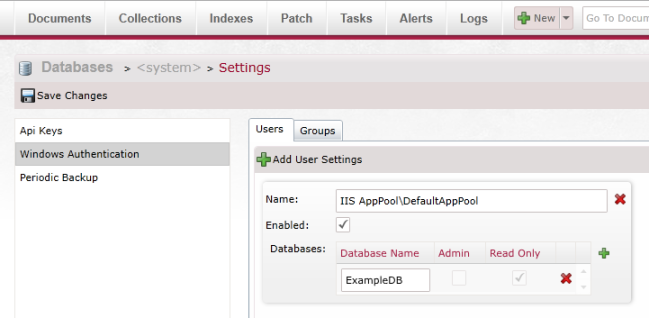Authentication & Authorization
#Authentication & Authorization
RavenDB comes with a built-in authentication functionality and it supports two types of authentication:
Appropriate authentication type is chosen by examining incoming request headers and by default all actions except read-only are being authenticated. To determine which actions will be authenticated please refer to Raven/AnonymousAccess configuration setting.
Windows Authentication
When action (request) needs to be authenticated and no other authentication method is detected, then the Windows Authentication is chosen. Worth noting is that all /admin endpoint requests are processed using this method.
By default all windows users and groups have access to all the databases, but this can be easily changed by editing Raven/Authorization/WindowsSettings document in system database. The document consists of list of users and groups that contain the list of accessible databases. For example this document could look like this:
{
"RequiredGroups": [],
"RequiredUsers": [
{
"Name": "IIS AppPool\\DefaultAppPool",
"Enabled": true,
"Databases": [
{
"Admin": false,
"TenantId": "ExampleDB",
"ReadOnly": true
}
]
}
]
}
Above example gives a read-only access to ExampleDB to IIS AppPool\DefaultAppPool. Similar effect can be achieved using the Studio and editing system database settings.
OAuth Authentication
Second supported authentication type is an OAuth authentication and to simplify the process, we have introduced the API key authentication described below.
Example - API keys
To authenticate the user by using API keys we need to create a document with Raven/ApiKeys/key_name as a key and ApiKeyDefinition as a content on system database.
store.DatabaseCommands.Put("Raven/ApiKeys/sample",
null,
RavenJObject.FromObject(new ApiKeyDefinition
{
Name = "sample",
Secret = "ThisIsMySecret",
Enabled = true,
Databases = new List<DatabaseAccess>
{
new DatabaseAccess {TenantId = "*"},
new DatabaseAccess {TenantId = Constants.SystemDatabase},
}
}), new RavenJObject());
Now to perform any actions against specified database (system database must be declared explicitly), we need to provide the API key.
var documentStore = new DocumentStore
{
ApiKey = "sample/ThisIsMySecret",
Url = "http://localhost:8080/"
};
Debugging authentication issues
This feature is available in RavenDB 2.0 build 2237 or higher.
To grant the ability to resolve authentication issues, we have introduced /debug/user-info endpoint that will return information about current authenticated user and it can be accessed by executing the following code:
var json = ((ServerClient) store.DatabaseCommands).CreateRequest("GET", "/debug/user-info").ReadResponseJson();
The returned results vary on the current authentication type:
- Anonymous
{
"Remark": "Using anonymous user"
}
- Windows Authentication with full access to all databases:
{
"Remark": "Using windows auth",
"User": "RavenUser",
"IsAdmin": "True"
}
- Windows Authentication with restricted access:
{
"Remark": "Using windows auth",
"User": "RavenUser",
"IsAdmin": "False",
"AdminDatabases": [],
"ReadOnlyDatabases": [ "ExampleReadOnlyDB" ],
"ReadWriteDatabases": [ "ExampleReadWriteDB" ]
}
- OAuth Authentication:
{
"Remark": "Using OAuth",
"User": "RavenUser",
"IsAdmin": "False",
"TokenBody": "<token_here>"
}
